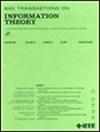Additivity of Quantum Capacities in Simple Non-Degradable Quantum Channels
IF 2.9
3区 计算机科学
Q3 COMPUTER SCIENCE, INFORMATION SYSTEMS
引用次数: 0
Abstract
Quantum channel capacities give the fundamental performance limits for information flow over a communication channel. However, the prevalence of superadditivity is a major obstacle to understanding capacities, both quantitatively and conceptually. In contrast, examples exhibiting additivity, though relatively rare, offer crucial insights into the origins of nonadditivity and form the basis of our strongest upper bounds on capacity. Degradable channels, whose coherent information is provably additive, stand out as among the few classes of channels for which the quantum capacity is exactly computable. In this paper, we introduce two families of non-degradable channels whose coherent information remains additive, making their quantum capacities tractable. First, we demonstrate that channels capable of “outperforming” their environment, under conditions weaker than degradability, can exhibit either strong or weak additivity of coherent information. Second, we explore a complementary construction that modifies a channel to preserve coherent information additivity while destroying the “outperforming” property. We analyze how structural constraints guarantee strong and weak additivity and investigate how relaxing these constraints leads to the failure of strong additivity, with weak additivity potentially persisting.简单不可降解量子通道中量子容量的可加性
量子信道容量给出了通信信道上信息流的基本性能限制。然而,超可加性的流行是理解能力的主要障碍,无论是定量的还是概念的。相比之下,表现出可加性的例子,虽然相对较少,但为非可加性的起源提供了至关重要的见解,并形成了我们能力最强上限的基础。可降解信道,其相干信息可证明是可加性的,在量子容量可精确计算的少数信道类别中脱颖而出。在本文中,我们引入了两类不可降解的信道,它们的相干信息保持可加性,使得它们的量子容量易于处理。首先,我们证明了在弱于可降解性的条件下,能够“超越”其环境的信道可以表现出强或弱的相干信息可加性。其次,我们探索了一种互补结构,该结构修改通道以保持连贯的信息可加性,同时破坏“优于”属性。我们分析了结构约束如何保证强和弱可加性,并研究了放宽这些约束如何导致强可加性失效,而弱可加性可能持续存在。
本文章由计算机程序翻译,如有差异,请以英文原文为准。
求助全文
约1分钟内获得全文
求助全文
来源期刊

IEEE Transactions on Information Theory
工程技术-工程:电子与电气
CiteScore
5.70
自引率
20.00%
发文量
514
审稿时长
12 months
期刊介绍:
The IEEE Transactions on Information Theory is a journal that publishes theoretical and experimental papers concerned with the transmission, processing, and utilization of information. The boundaries of acceptable subject matter are intentionally not sharply delimited. Rather, it is hoped that as the focus of research activity changes, a flexible policy will permit this Transactions to follow suit. Current appropriate topics are best reflected by recent Tables of Contents; they are summarized in the titles of editorial areas that appear on the inside front cover.
 求助内容:
求助内容: 应助结果提醒方式:
应助结果提醒方式:


